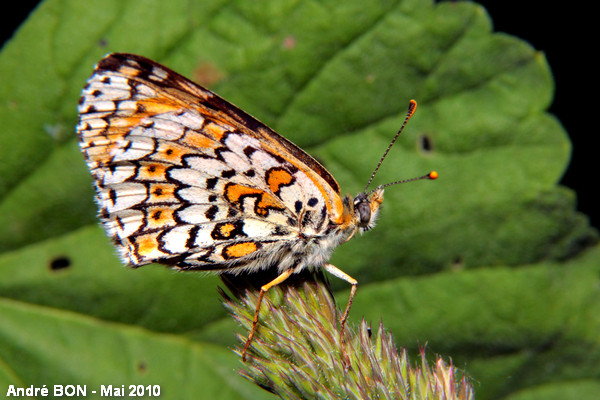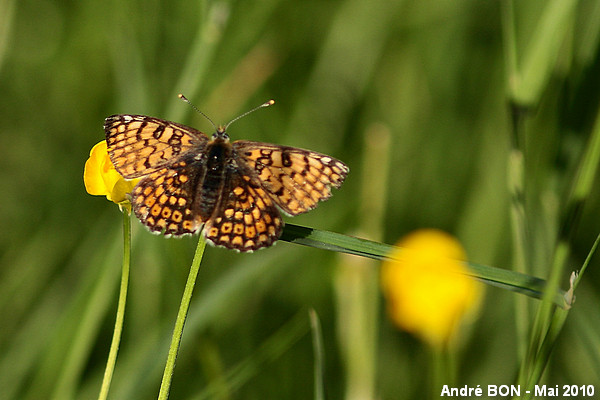


| Glanville Fritillary (Melitaea cinxia (Linnaeus, 1758)) |



|
|
Scientific name: Melitaea cinxia (Linnaeus, 1758) Common name: Glanville Fritillary French name: Mélitée du plantain, Déesse à ceinturons, Damier du plantain. Order: Lepidoptera Suborder: Rhopalocera Family: Nymphalidae Subfamily: Nymphalinae Wingspan: 33 to 43 mm. Biotope: Open flower meadows. Geographic area: Europe and Asia except extreme north, North Africa. Flight time: May-June and then August-October. Number of generations : 2,(only 1 brood in the northern part of its range). Caterpillar: Black body with spines. It shows small white dots between segments. The head is reddish brown. Host plant: Plantains (Plantago sp.), Starthistles (Centaurea sp.) and Speedwells (Veronica sp.) |
The upper side of the wings is reddish orange or yellowish orange with a reticulated black pattern. Females are a duller colour than males with larger black marks. The hind wings show a series of black dots in the submarginal stripe. This particularity is only found on one other species, the Freyer's Fritillary (Melitaea arduinna) which is only found in south-east Europe and Asia. The black dots in the orange submarginal stripe are clearly visible on the underside of the wings too. The shape of the inner black border of this submarginal stripe is also a key to tell the Freyer's Fritillary apart from the Glanville Fritillary. On Glanville Fritillary, this border draws well-marked semi-circles with the round part towards the outer edge of the wings. It draws more straight lines on Freyer's Fritillary and even curves with the opposite orientation. |
| [To know more about the Glanville Fritillary] [Next picture] [Top] |

|
I have observed this Glanville Fritillary in a water meadow of the Basse Vallée du Doubs in France. It was totally immobile and I have been able to get very close. I could have touched it with my fingers. |
| [To know more about the Glanville Fritillary] [Next picture] [Previous picture] [Top] |

|
As I am not yet equipped with true macro lenses, I had to use the flash to shoot this close-up picture. However nothing is better than natural light... |
| [To know more about the Glanville Fritillary] [Previous picture] [Top] |

|
Here is an upper side view. You can clearly see the black dots in the submarginal stripe on the hind wings. |